Biography
Interests
Younes Ahmad Aly*1, Zohdy Nawal, Z. M.1, Abul Fadl Hazem2 & Fathy Reham2
1Department of Entomology, Faculty of Science, Cairo University, Giza, Egypt
2Plant Protection Research Institute, Agricultural Research Center, Dokki, Giza, Egypt
*Correspondence to: Dr. Aly Younes, A., Department of Entomology, Faculty of Science, Cairo University, Giza, Egypt.
Copyright © 2018 Dr. Younes, A. A., et al. This is an open access article distributed under the Creative Commons Attribution License, which permits unrestricted use, distribution, and reproduction in any medium, provided the original work is properly cited.
Abstract
The tomato leaf-miner, Tuta absoluta Meyrick (Lepidoptera - Gelechiidae), is a widespread insect develops on many important solanaceous crops. The preference and performance of its host range could help in understanding and preventing the dispersion behavior of this pest in the environment. A choice experiment with whole plants was conducted with three selected hosts: tomato (Lycopersicum esculentum Mill), potato (Solanum tuberosum L.), eggplant (Solanum melongena L.) to examine adult ovipositional preference. T. absoluta performances taking into consideration larval, pupal and adult development and survival parameters were conducted. The females preferred tomato to lay their eggs in the triple- or dual-choice experiments. Also, performance of larvae showed growth preference with tomato plants. Survivorship of larvae, pupae and adults with tomato plants was also the most profound. A significant correlation was obtained between the ovipositional preference and fitness levels (performance) of larvae, pupae and adults. This study indicates high ovipositional preference was correlated with short developmental times and high survival rates of T. absoluta which may relate to a suitable food quality.
Introduction
The tomato leafminer, Tuta absoluta (Meyric) (Lepidoptera - Gelechiidae) is a pest of great economic
importance in a number of countries. Its primary host is tomato although potato, egg-plant, common weed
and various wild solanecous plants are also suitable hosts [1,2]. It is known to be a devastating pest of
tomato originating from South America and has now invaded various European countries and dispersed
throughout the Mediterranean basin [3].
Little is known about the trophic relationship between T. absoluta and its potential host-plants other than tomato. Different patterns of host-plants used by insect pests are related to differences in physiology, morphology, chemical and physical defenses of the plants, with subsequently differences in the insect life history traits [1,4].
Quality and quantity of food consumed by herbivores insects affect growth, survival and fecundity of individuals; and hence their population improvement [5]. Host plant choice is important for fitness of Lepidoptera [6]. The neonate larvae of many species are unable to move to an alternative food source and are dependent on their mother’s choices. Classically females are attracted to the odor blends released by plants which signal oviposition site and so larval food sources [7,8,9]. Consequently, insect management strategies based on preference and performance of host plants involve the development of cultivars that have enhanced direct or indirect defense mechanisms [10], the use of polyculture [11], or the extraction of plant volatiles to develop products that lure insects [12].
The objective of this study was firstly studying the ovipositional preference of T. absoluta female towards the three different solanaceous plant cultivars. Secondly, evaluating the relative preference affects the performance of T. absoluta life stages on the three solanaceous hosts which are tomato (Lycopersicum esculentum Mill), potato (Solanum tuberosum L.) and eggplant (Solanum melongena L.).
Materials and Methods
The tomato leaf-miner, T. absoluta colony was established as larvae collected from tomato growers at ELNatron
Valley area (30° 30ʹ 26ʺ N, 13° 30ʹ 03ʺ E). Collected larvae were reared on tomato leaves, fresh leaves were provided daily till pupation. Emerging moths were sexed, 15 pairs of both sexes of the moth were kept inside a plastic oviposition container (25 x 15 x 10cm) sealed at the top with a fine mesh net and provided by small foliage of tomato for oviposition. After 24 h, the eggs laid were collected and divided into three
groups. Within the group, each egg was transferred into 10cm-Petri dish.
Fresh host plant leaves (tomato, potato or eggplant) were provided for larval feeding in dishes and were replaced every other day. The fourth instar larvae were transferred into small plastic tubes (3cm diameter, 6cm depth) for pupation.
Experiments have conducted after rearing T. absoluta for three generations. The insect colony and the experiments were conducted in a greenhouse (3 x 4 x 2m) greenhouse equipped with a drip irrigation system located at Biological Control Department, Agricultural Research Center, Giza. The laboratory conditions during the experiments were: an average temperature of 25±3°C; relative humidity ranging from 70% to 85% and a photoperiod of 14:10 h (L: D).
Seeds of tomato, eggplant and tubers of potato were cultivated in a greenhouse condition and in seedling
trays containing peat moss until the growth of the first leaves. Thereafter, the seedling were transferred to 5 L
pots (one plant/pot) containing the main substrate of the greenhouse. The plants were fertilized firstly with
cattle manure and after two weeks a mixture of ammonium sulfate and potassium chloride (3:1) were used
weekly to fertilize the plants. Other cultural practices, such as staking and irrigation, were performed daily
throughout the plant developmental area. The experimental design was completely run with 30-45-day-old
plants.
Two flying tunnel types; three arms-tunnels (Figure 1) and two arms-tunnels (Figure 2) were used to study
the oviposition preferences of T. absoluta towards different solanaceous plants (tomato, potato and eggplant).
Both three-choice and dual-choice oviposition tests were conducted. The flying tunnel consists of three or
two arms and central area. Each arm has length × width x high of 90 × 60 × 60cm. The central zone (40 ×60
× 60cm) has an open up hole for insect release. Each tunnel arm has an open hole (20×20cm) to facilitate
the air follow. The flying tunnels were made from the transparent glass to facilitate light pass. Each tunnel
arm hole is coated with a thin mesh that allows the air to pass and prevents the exit of the female moth.
Three-day-old females were used in this experiment after they allowed mating with males.


At the beginning of the experiment, the plants (4-week-old) were put in the arms (one plant in each arm). The three and two different host plants were used in the triple and dual choice experiments, respectively. The female was released through the central zone hole and allowed to choice its oviposition site (host plant) for 24h, and then the number of eggs laid on each host plant was counted. The position of host plant in the arm site was reciprocal changed. Both the host plant and so the female moth were used only once. Fifteen females (emerged from larvae fed on tomato, potato or eggplant in an equal numbers) were used for each experiment.
Three generations of T. absoluta were reared on each of the selected host plants (tomato, potato or eggplant)
before beginning of the experiments. Adults of the third generation were transferred to ovipositional
cylinders containing fresh leaves of host plant and a thin layer of 10% honey on pepper ribbons. Eggs were
collected daily with a moistened brush and kept individually in Petri dishes lined with moistened filter
paper to establish the experimental colony for each host plant species. Eggs laid on the same day were
placed individually into separate Petri dishes (4cm diameter) containing host plant leaves (tomato, potato
or eggplant). Thirty eggs per host plant were used. Fresh foliage was provided for newly emerged larvae and
observed daily till pupation and adult emergence.
Insect individuals were checked daily for development and survival. Egg incubation periods (days), egg hatching (%), larval developmental periods (days) and pupal periods (days) were recorded. Survival rate for each stage was also recorded.
Newely emerged adults (one male and one female) were transferred into wooden rearing cage (30×30×20cm) lined with tulle and containing host plant foliage (tomato, potato or eggplant) and fed on 10% sucrose
solution. Fresh foliage was provided as ovipositional medium. Adult’s longevity was recorded daily.
Variables were first tested for normality before analysis. Data are presented as mean ± SEM and analyzed
by one-way analysis of variance (ANOVA) followed by comparison of the means with Tukey test at α =
0.05. Furthermore, a paired t-test was performed to detect the relation between ovipositional preference and
developmental performance on various host plants using software Graphpad Instat (2009) [13].
Results
The number of eggs deposited by T. absoluta females on each of the three plant species (tomato, potato
and eggplant) in the three-choice or dual-choice tests indicated a strong oviposition preference for tomato
plants. Each female laid 8.50±0.51 eggs/day (66.6%) on tomato plants in comparison with 2.66±0.45 eggs/
day (20.8%) on potato plants and 1.60±0.25 eggs/day (12.5%) on eggplant as shown in table (1) and figure
(3). Statistically, in the three-choice test, T. absoluta female significantly preferred tomato plants for egg
deposition than potato and eggplant (F(2,42)= 79.34; P= 0.043). In the dual choice test including tomato
compared with potato, tomato compared with eggplant and potato compared with eggplant, the females of
T. absoluta preferred tomato plant over potato or eggplant. They laid 10.07±0.68 eggs/day (79.5%) on tomato
plants compared with 2.60±0.49 eggs/day (20.5%) on potato plants. Statistically significant differences
(t = 8.82; df = 28; P<0.0001) were obtained as shown in table (2) and figure (4). Percentage deposited
eggs on tomato plant was increased to 91.23% with mean egg numbers of 10.40±0.64 eggs/day when the
dual-choice experiment included tomato and eggplant as shown in table (3) and figure (5). The females
significantly preferred tomato to oviposition than eggplant (t= 12.78; df= 28; P< 0.0001). When females
exposed to potato and eggplant in a dual-choice test, they preferred potato for oviposition than eggplant
with a percentage of 81.67 % and a mean number of 8.60±0.46 eggs/day as shown in table (4) and figure
(6). Statistically, T. absoluta female significantly preferred potato for oviposition compared to eggplant (t=
11.50; df= 28; P< 0.0001).
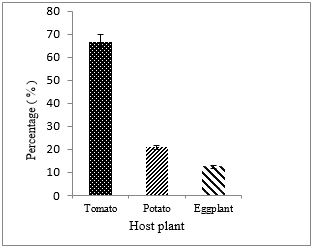
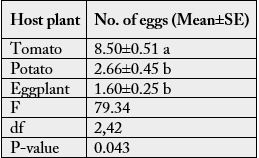
-Means followed by the same letter, in the same column, are not significantly different (P>0.05).
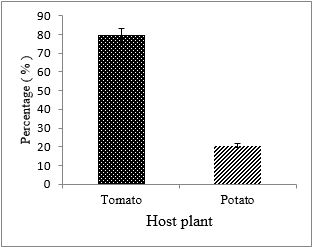
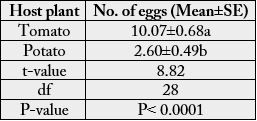
-Means followed by the same letter, in the same column, are not significantly different (P>0.05).
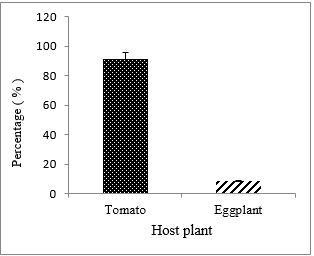
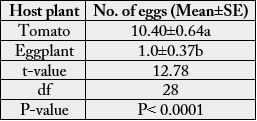
-Means followed by the same letter, in the same column, are not significantly different (P>0.05).
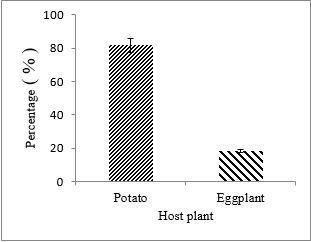
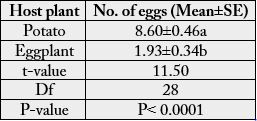
-Means followed by the same letter, in the same column, are not significantly different (P>0.05).
Table (5) shows the duration of different immature stages and total developmental time of T. absoluta reared on tomato, potato and eggplant leaves. The incubation periods of eggs ranged from 5.22± 0.09 to
5.25±0.09 days. Statistically, no significant difference was found among the three host plants regarding
egg durations (F (2,87) =0.29; P = 0.74). The differences in the duration periods were obtained considering
larvae fed on tomato leaves and those fed on potato or eggplant leaves. The mean duration period of the
larvae that fed on tomato leaves was 10.83±0.18 days in comparison with 13.30±0.31 and 13.13±0.33 days
in the case of larvae fed on potato and eggplant leaves, respectively. Statistically, significant difference was
obtained between the duration of larvae fed on tomato leaves and those fed on potato or eggplant leaves
(F(2,87) = 24.05; P< 0.0001). The same significant differences were obtained considering durations of
pupae obtained from larvae fed on tomato, potato or eggplant leaves (Table 5).
The total developmental period of larvae fed on tomato leaves was the minimum (24.45±0.25 days) in comparison with those fed on potato (28.38±0.33 days) or eggplant (28.69±0.30 days). Larvae fed on potato or eggplant leaves developed approximately slower 3-4 days than those fed on tomato. Statistically, significant difference was obtained in comparison the total developmental period of T. absoluta larvae fed on tomato and those fed on potato or eggplant (F (2,70) = 67.3; P < 0.0001)

-Means followed by the same letter, in the same column, are not significantly different (P>0.05).
The survival rate (lx) of T. absoluta reared on tomato, potato or eggplant leaves is shown in figure (7) and
table (6). The survival of the egg stage was 100% for T. absoluta fed on tomato, potato or eggplant. The
highest survival rate of immature stages was obtained with larvae fed on tomato leaves (86.7%) while
survival rates of 83.4% and 80.1% were obtained for larvae fed on potato and eggplant leaves, respectively.
Age-specific mortality revealed that 13.3%, 13.3% and 16.6% mortality was obtained for larvae fed on
tomato, potato and eggplant, respectively. On the other hand, age-stage mortality of pupae of resulting
from larvae fed on potato or eggplant was 3.3% while no pupal mortality (0%) was obtained for pupae
resulting from larvae fed on tomato.
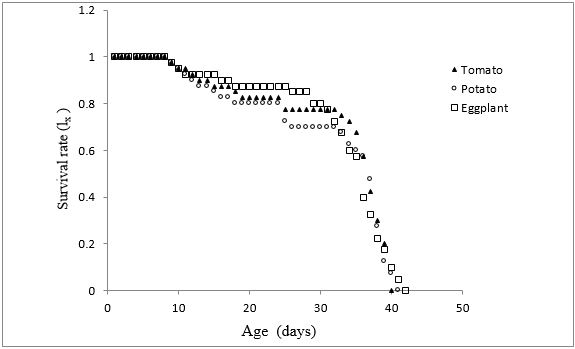
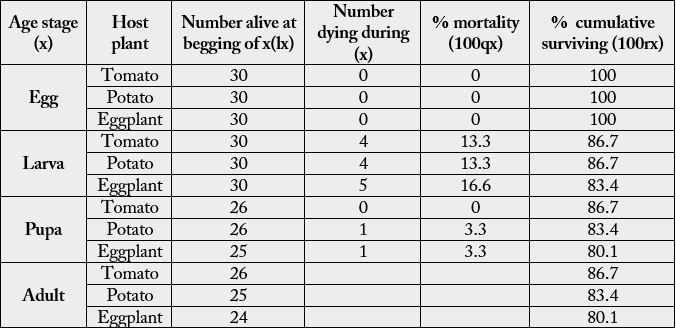
x = developmental stage; lx= number entering stage; 100qx = percent apparent mortality; 100rx = percent cumulative surviving.
T. absoluta adult moths emerged from larvae fed on different host plants showed different life spans
as shown in table (7). Both sexes emerged from larvae reared on tomato leaves lived longer than those
emerged from larvae reared on potato or eggplant leaves. Life span of females resulting from tomato-fed
larvae was 13.78±0.17 days in comparison with 12.29±0.16 days and 11.47±0.21 days for female moths
resulting from larvae fed on potato or eggplant, respectively. Statistically, significant difference (F (2,37) = 42.68; P < 0.0001) was obtained in comparison the life span of females emerged from tomato-fed larvae and those emerged from potato- or eggplant-fed larvae. Males resulting from tomato-fed larvae had longer life span (10.35±0.17 days) in comparison with those emerged from potato (9.43±0.20) days and
eggplant-fed larvae (10.13±0.25) days. Statistically, significant difference was obtained considering life span of males resulting from tomato, eggplant and potato-fed larvae, respectively (F (2,33) = 5.6; P= 0.008).
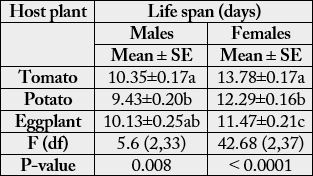
-Means followed by the same letter, in the same column, are not significantly different (P>0.05).
Correlation of T. absoluta Ovipositional Preference and Performance
Ovipositional preference and performance of T. absoluta correlated significantly among host plants. Most eggs were laid on tomato, whereas the least on eggplant. Correlation of ovipositional preference with developmental period, survival and female life span is shown in table (8). Significant correlations ware
obtained between oviposition preference and developmental time (t = 6.53; p = 0.022), survival (t = 12.78; 0.006) and female life span (t = 5.54; p = 0.03).

Discussion
Many plants belonging to family Solanaceae have been cited as host-plants for T. absoluta [14], however studies regarding their suitability to insects are lacking. According to the present investigation, T. absoluta
is developed almost on tomato and at the same time it could develop and grow, but with lower rate, on potato and eggplant. The availability of alternative host plants is an important factor that allows the sustainability of the pest in the absence of the primary host (tomato). This capacity must be carefully considered with integrated control strategies. Our study showed that tomato is a more suitable host-plant than potato
or eggplant.
The ovipositional choice of female T. absoluta was host plant species-dependent. According to Awmack and Leather (2002) [15] and Gripenberg et al. (2010) [16] lepidopteran larval survivability depends on the females’ oviposition choice because most of them are unable to move to an alternative food source. Ovipositional preference experiments showed that T. absoluta more preferred tomato plant than potato and eggplant. Also, potato was more preferred by the female than eggplant. The study of Proffit et al. (2011) [17] indicated that the attraction and oviposition of female T. absoluta are mediated by the volatile signature of their host plant. Also, they elucidated that tomato leaf odors mainly include volatile terpenoid compounds which elicit in mated females upwind orientation flight followed by landing as well as egg-laying. In the current study, previous feeding experience of the larvae did not influence host acceptance (adult oviposition), because tomato-, potato- and eggplant- reared larvae could not affect the ovipositional preference of the female which preferred tomatoˈs plant. This finding may agree with that of Capparos Megido et al. (2014) [18] as they reported that during oviposition, females are exposed to a variety of cues, including plant volatiles, contact chemicals, and visual signals, which help in determining the characteristics of the plant. Consequently, the host plant experience, have little effect on the adult ovipositional preference. Oviposition on a suitable host in response to plant cues is of major importance for an insect to maximize its fitness [19].
In our study the less developmental time and high survival rate of T. absoluta fed on tomato compared to those fed on potato or eggplant seem likely to be attributed to high nutritional quality of tomato. Slansky (1993) [20] concluded that quality and quantity of food consumed by herbivore insects affect the growth, survival and fecundity of individuals and hence their population improvement.
Although marginally statistical differences between tomato and the two other plants (potato and eggplant) were observed, T. absoluta successively developed on potato and eggplant. Preference and performance parameters obtained from cohorts of T. absoluta reared on tomato, potato and eggplant under laboratory conditions are useful for the assessment of biotic potential of this pest. Sanchez and Pereyra (1995) reported that demographic parameters obtained from cohorts reared on different host plants under laboratory conditions are useful for assessment of the biotic potential of an insect facing a new food and for the evaluation of the host-plant quality.
Plant species differ greatly in suitability as hosts for specific insects when assessed in terms of survival, development and reproductive rate. Shorter developmental time along with greater total reproduction of insects on a host indicate greater suitability of a host plant [21]. High survival rates, short development times and high fecundity rated (number of eggs per female) of herbivorous insects are all related to a suitable food quality [14,22].
The present study demonstrated the relationship between adult oviposition preference and offspring performance. It is obvious that T. absoluta female prefers to oviposit on tomato that suitable for survival and development of its offspring compared to potato and eggplant. Tomato plants can be used as trap plants on field edges of potato or eggplant in developing IPM strategies for the control of T. absoluta.
Authors’ Contribution
AY and NZMZ conceived and designed the research. HAA and RF conducted the experiments. AY and RF
analyzed the data and wrote the manuscript. AY and NZMZ made critical reviewed and approved the final
version. All authors reviewed and approved the final manuscript.
Acknowledgment
The authors would like to thank Prof. Dr. Sayed Shaurub; the head of the Entomology Department, Faculty
of Science, Cairo University. His help and guidance had the greatest impact in completing this work.
Conflict of Interest
The authors declare that they have no conflict of interest.
Bibliography

Hi!
We're here to answer your questions!
Send us a message via Whatsapp, and we'll reply the moment we're available!